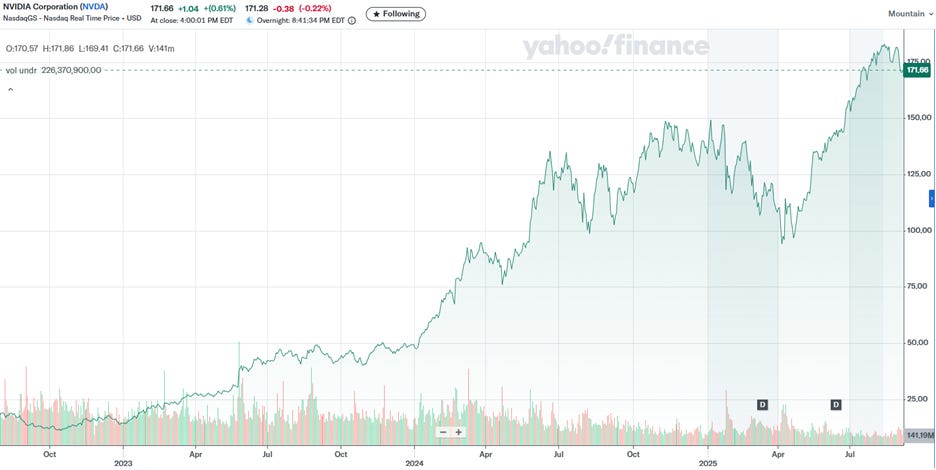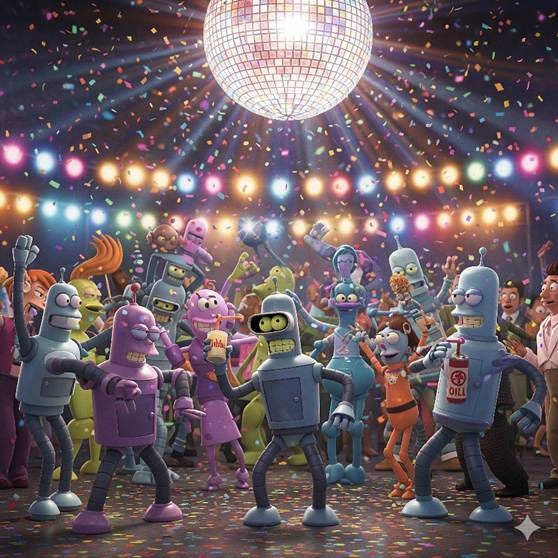Is AI a Bubble?
No, but turbulence is a feature of dynamic technology-driven economic shifts such as AI. The path to AI Superintelligence is not a straight line.
Anthropic’s Big Raise
Whether AI is in a bubble has been a hot topic in technology and finance circles this summer. I decided to weigh in on the topic when I heard about the eye-popping fundraising round by Anthropic of $13B at $183B post-money valuation.
Anthropic won investors over because Claude AI models lead in AI coding and their annual revenue run rate is now $5 billion, up from a fraction of that last year.
The bear case for Anthropic is that most of their revenue relies on just two customers, GitHub Copilot and Cursor, who can switch AI models at any time. They are behind OpenAI and Google overall in market share and AI models, and many other AI labs compete in the same foundational AI model space that might get commoditized.
Investors are discounting the concerns betting on Anthropic’s growth. Investor exuberance contrasts with media outlets putting a negative spin on AI stories lately. This divergence begs the question: Are investors irrationally exuberant about AI, or is the recent downbeat media narrative just overly pessimistic?
Surging Valuations and Funding Frenzy
AI companies in 2025 have experienced a remarkable surge in valuations and funding, and most of the action has been in the private market. Over 50% of venture dollars in early 2025 went to AI startups, with half-year funding outpacing all of 2024. Some remarkable examples:
Earlier this year, OpenAI closed a $40 billion round at a $300 billion valuation, the largest ever for a private tech firm. To put this in perspective, a company that had barely any revenue in 2022 now has a market capitalization that places it in the top 30 largest firms.
Toronto-based Cohere raised $500 million at a $6.8 billion valuation last month.
EliseAI secured $250 million at a valuation of over $2.2 billion, doubling its earlier raise.
Anysphere, maker of Cursor, raised $900 million at a value of nearly $10 billion.
In the public markets, the best pure-play on AI has been Nvidia, which is now the most valuable company in the world. Nvidia has increased in market cap ten-fold since the ChatGPT moment due to its success with AI chips and AI supercomputers.
The top 6 companies in the world by valuation – Nvidia, Microsoft, Apple, Alphabet (Google), Amazon, Meta – are technology companies with big exposure to AI, making big bets on AI to secure future business. The $17 trillion in combined valuation of these companies is elevated due to AI.

Dot-Com Bubble 2.0?
Massive investments and soaring valuations prompt flashbacks to the dot-com era, when the Internet technology excitement led to massive hype, hope, valuations, and then a shakeout.
There are many parallels: Both AI and the internet are fundamental technology shifts; both technology shifts have been led by startups challenging the old order; both are seeing a very frothy and dynamic investment environment, and history tells us there will be a few big winners and many losers come out of it.
There are also some differences. The internet dot-com bubble was fueled by easy money (the Fed had kept monetary policy easy due to Asian financial crisis and the Y2K scare); that plus technology hype that led to “irrational exuberance”. We have plenty of AI hype, but not so much easy money right now.
The shape of the AI revolution is different as well:
AI adoption curves are faster and bigger than the internet. We spoke about the massive AI adoption by consumers and the enterprise here.
AI company revenues are significant and growing, unlike many of the early internet companies. Many AI startups are pulling ahead on real revenues and differentiated IP.
AI company market caps are far larger than the 1990s internet startup values. Will bigger values mean a bigger fall in a shakeout? While some valuations are indeed lofty, Big Tech companies with market caps elevated by AI exposure have other businesses to rely on to even out the AI exposure risk.
AI Hype Cools Down
Are we in a phase where investors as a whole are overexcited about AI? My opinion is yes. Is AI the most important thing to happen in a very long time? My opinion is also yes. – Sam Altman
Recent months have shown signs of AI hype colliding with reality, which has fed narratives of failing AI progress. The reception to OpenAI’s GPT-5 model was mixed; some were underwhelmed by a model that didn’t meet its own hype. OpenAI removing older AI models with GPT-5 release, then giving users back GPT-4o and other models added to the confusion.
The media treated Meta’s AI division chaos as a sign of pervasive AI industry challenges rather than a single company issue.
Then there is the recent MIT study that found that “95% of companies investing in generative AI have yet to see any financial returns,” which was spun into a story of widespread failures of AI deployments.
Even Nvidia posting record earnings has been treated as a story of “cooling growth” and Nvidia hitting a speed limit. The real story is that growth has been so significant already, with Nvidia earning $46.7 billion in revenue this past quarter, that future growth will have to be slower. Nvidia is eating up a huge proportion of (growing) cloud provider Capex.
Another example of anti-hype is The Register headline “Goldman Sachs warns AI bubble could burst datacenter boom.” Behind the headline, Golman Sachs estimates datacenter capacity will surge by 50% by 2027. They add some caveats:
Datacenter capacity is forecast to surge 50 percent by 2027 driven by AI demand, with the sector's energy consumption doubling by 2030, according to the latest research from Goldman Sachs. But the financial services biz says it's watching for signs that AI adoption may fall short of current hype.
These analysts aren’t saying the sky is falling, they are hedging their bets on a prediction of significant growth. They see that AI growth is rapid but constrained.
Certainly, AI demand could falter if AI projects overall disappoint. And if AI adoption falls short of projections, then cloud providers will retrench on their hefty AI infrastructure investments. The AI bubble perhaps could burst if all that comes to pass.
Why the Bubble Talk Is Overblown
While it is possible, even likely, that there will be AI “boom” and “bust” sentiment and investment cycles, just as we’ve seen with prior technologies, it’s highly unlikely that AI will crash and burn soon. Here’s why:
It’s a supply-constrained market: Power constraints are limiting AI data center buildouts. Wafer and packaging capacity has limited Nvidia’s chip output. There are backlogs on supply, so if there is a lapse in the demand growth, it might not be an AI bubble bursting but “the pause that refreshes” and resets us to more sustainable growth.
AI Demand is Surging: AI usage in 2025 has surged. For example, Gen AI usage among business leaders jumped from 55% to 75%. In May, we called this phase of AI the “Era of AI adoption.” AI’s adoption is genuine, and usage grows in tandem with AI growing in its capabilities and utility.
We are in AI’s Early Innings: AI’s economic transformation is only beginning, with most AI use moving from pilot to enterprise adoption just this year. We are starting to deploy AI agents widely now, learning early lessons in AI enterprise adoption. Major tech companies like Microsoft stress that enterprise value from AI is just starting to appear, and they expect AI demand to drive infrastructure and software spending for years.
AI is a big opportunity: Sequoia speaks of AI displacing not the software market but being a $10 trillion market opportunity, which is over an order of magnitude bigger than the entire software market.
AI technical progress is continuing, with better AI reasoning, more autonomous AI agents, and new AI applications. This will keep fueling more AI use cases and drive more AI adoption.
A non-straight line to AI Superintelligence
The AI investment scene is highly speculative right now, with exuberant valuations, big funding rounds, and high investor expectations. Fundamental technology shifts like the railroad and internet went through speculative bubbles, and AI is likely to do the same.
The internet bubble bursting in 2000 happened early in the story of the internet. The internet kept growing, becoming ever more important and pervasive. Twenty-five years after the internet bubble burst, key internet tech companies like Google and Amazon are more valuable and important than ever.
So too with AI. Without a doubt, there will be AI shakeouts. Some AI startups won’t survive heavy competition, either lacking deep pockets or profitable business models. It’s the nature of a dynamic and fast-changing technology shift.
However, the foundational role AI is poised to play across industries should make us consider the long game. AI is a massively valuable transformation as significant as the industrial revolution, poised to automate cognitive work instead of physical labor.
AI is undergoing massive growth and improvement and with that change comes uncertainty. That uncertainty feeds cycles of hype and disillusionment. Like a high growth stock, sentiment and valuations get volatile.
Some market pundits speak of bull markets as “Climbing a wall of worry.” The skepticism and second-guessing media narratives keep AI exuberance tamped down and force us to re-assess periodically. This is helpful to AI progress long-term, even if the optimists are more right about AI in the long-term.
AI is not a bubble. Macro factors or barriers in AI adoption or AI improvement may well bring a market correction or a “bubble burst” or worse down the road, but even if that happens, AI innovation and adoption will persist and grow.
Actionable Insights
This is not an investment newsletter, but some might wonder what is actionable from this article. After all, if you were a subscriber in mid-2023, you would have read my article on Nvidia and might have done quite well realizing Nvidia’s opportunity.
The AI investment thesis: AI is a fundamental technology shift; there will be shakeouts and perhaps crashes, with winners and losers; but AI as a whole will be much more valuable in the long run, possibly a $10 trillion market opportunity.
How to invest in this AI scenario? For those who cannot invest in venture-backed private AI startups, you can get exposure to top AI companies via the stock market. Most, like Nvidia and Microsoft, are already richly valued, but I’d bet on two under-rated AI companies: Alibaba, the maker of the Qwen AI models; and Google, about to reclaim the top AI model crown when they release Gemini 3.
Stay long AI.



https://open.substack.com/pub/pramodhmallipatna/p/the-ai-bubble-meets-the-chasm